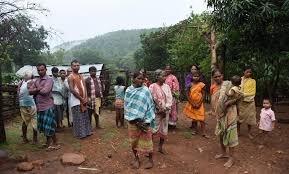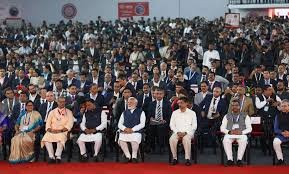Mankidia Community Becomes 6th PVTG to Get Habitat Rights Over Forests in Odisha
Introduction
In a significant development for indigenous rights in India, the Mankidia community, categorized as a Particularly Vulnerable Tribal Group (PVTG), has been granted habitat rights over the forests in Odisha. This recognition makes the Mankidia community the sixth PVTG to receive such rights in the state under the Forest Rights Act, 2006. The initiative strengthens the community’s traditional relationship with forests and provides legal backing to their livelihood and cultural practices.
Grant of Habitat Rights
The Mankidia community has long been dependent on forests for their sustenance, with activities such as hunting, gathering forest produce, and weaving making up the backbone of their lifestyle. By granting habitat rights, the government acknowledges the community’s age-old practices and secures their legal access to forest resources. The habitat rights come under the provisions of the Forest Rights Act (FRA) of 2006, which aims to correct historical injustices faced by forest-dwelling communities.
Odisha’s Role in Tribal Welfare
Odisha has been at the forefront of promoting tribal welfare, particularly for PVTGs. The state has already extended similar rights to five other PVTGs, reinforcing its commitment to inclusive development. This latest recognition for the Mankidia community is expected to pave the way for improved socio-economic conditions, particularly in areas related to education, healthcare, and infrastructure.
Sustainable Coexistence
One of the key advantages of granting habitat rights is fostering sustainable coexistence between indigenous people and their environment. Communities like the Mankidia possess deep knowledge of biodiversity and forest conservation practices that are vital for maintaining ecological balance. By acknowledging their habitat rights, the state recognizes the role of indigenous knowledge in conservation efforts.
Implementation of Forest Rights Act
The Forest Rights Act of 2006 has been a crucial tool in securing the land and habitat rights of marginalized communities. The act empowers tribal groups and forest dwellers to legally claim land for their habitation and livelihood. The implementation in Odisha, particularly for PVTGs, has been progressive, setting an example for other states.

Why This News is Important
Protection of Indigenous Rights
This news is significant because it highlights the protection of indigenous rights in India, particularly for the Mankidia community. The recognition of habitat rights is not just a legal acknowledgment but also a step toward securing the livelihoods of marginalized tribal communities. For students preparing for government exams, it is essential to understand the implications of such policy decisions on tribal welfare and forest governance.
Promoting Sustainable Development
The news is also important from an environmental perspective. The recognition of habitat rights for the Mankidia community aligns with sustainable development goals by promoting traditional ecological knowledge and practices. For government exam aspirants, it is crucial to grasp how indigenous knowledge contributes to forest conservation and biodiversity.
Exam Relevance
This development relates directly to topics in current affairs, Indian polity, and environmental studies, which are key areas in exams such as IAS, UPSC, and other state-level civil services. Understanding the legal framework surrounding the Forest Rights Act and its implementation at the grassroots level will be vital for answering exam questions on tribal welfare and environmental policies.
Historical Context
Forest Rights Act of 2006
The Forest Rights Act (FRA) was enacted to address the long-standing exclusion of tribal and other forest-dwelling communities from the legal framework governing forests. Before this act, communities like the Mankidia were often denied legal rights to their traditional lands, leading to forced evictions and loss of livelihood. The FRA corrected these injustices by granting land and habitat rights to eligible communities, allowing them to sustain their way of life.
Odisha’s Tribal Heritage
Odisha is home to 13 PVTGs, making it one of the most tribal-rich states in India. Historically, the state has taken initiatives to safeguard the rights of its tribal population, particularly through land reforms and welfare programs. The Mankidia community, known for its nomadic lifestyle and dependence on forest produce, has long been fighting for habitat rights. With this latest recognition, they join the ranks of other PVTGs in Odisha who have received similar entitlements.
Key Takeaways from Mankidia Community’s Habitat Rights
| S.No | Key Takeaway |
|---|---|
| 1 | Mankidia community becomes the 6th PVTG in Odisha to get habitat rights under the Forest Rights Act of 2006. |
| 2 | The recognition grants the Mankidia community legal access to forest resources essential for their livelihood. |
| 3 | Odisha is a leader in tribal welfare, with five other PVTGs already granted similar habitat rights. |
| 4 | The habitat rights aim to promote sustainable coexistence between indigenous communities and forests. |
| 5 | The Forest Rights Act of 2006 continues to be a crucial tool for securing the land rights of marginalized communities. |
Important FAQs for Students from this News
Q1: What is the significance of the Forest Rights Act (FRA) 2006?
The Forest Rights Act, 2006 aims to address the historical injustice faced by forest-dwelling communities, particularly indigenous tribes, by granting them legal rights to land and forest resources for habitation and livelihood.
Q2: Who are the Mankidia community?
The Mankidia community is a Particularly Vulnerable Tribal Group (PVTG) in Odisha, known for their nomadic lifestyle and reliance on forest resources for activities like hunting and weaving.
Q3: What does the term PVTG mean?
PVTG stands for Particularly Vulnerable Tribal Groups. These are tribal groups that are characterized by low development indices, including low literacy, subsistence-based economies, and dependence on forests for livelihood.
Q4: How does the recognition of habitat rights benefit the Mankidia community?
The recognition of habitat rights legally secures the Mankidia community’s access to forest resources, helping preserve their traditional lifestyle and ensuring their right to the forests for sustenance and culture.
Q5: How many PVTGs in Odisha have received habitat rights under the FRA?
With the inclusion of the Mankidia community, a total of six PVTGs in Odisha have been granted habitat rights under the Forest Rights Act of 2006.
Some Important Current Affairs Links


















